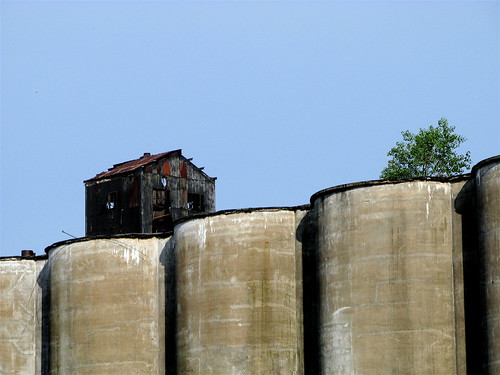Buffalo Silos with Elevator Behind
The Welland Canal (1932) and the St. Laurence Seaway (1959) replacing the Eire Canal were the end of the Buffalo grain industry that built the magnificent silos still standing at the water's edge. Higher transportation bandwidth replaced the need for a regional storage and processing centre and now the business in Buffalo has dropped to a trickle.
Following a Twitter thread on #eresearch I found an article by Stephen Nichols on Ariadne Issue 58, Time to Change Our Thinking: Dismantling the Silo Model of Digital Scholarship. The call for dismantling silos in humanities computing isn't new and it is worth noting some of the contexts it has appeared in:
- Domenico Fiormonte, among others, has argued that there is a "anglo-american" domination of humanities computing - a sort of pseudo imperial silo by language and nation that marginalizes groups in other countries. See my post on Fiormonte's blog and essay.
- There are social publishing tools like ThoughtMesh that try overcome silos.
- Most notably there is A Survey of Digital Humanities Centers that Diane M. Zorich prepared in the United States for the Council on Library and Information Resources that is critical of the lack of collaboration between centres (centers) in the United States.
Nichols reaction to the silos, by which he means isolated digital archives is to describe the collaboration of his group at Johns Hopkins and the Bibliothèque nationale de France to create the Roman de la Rose project. Such projects represent a reorientation from projects that are focused on sites (as in the project of University X) to projects that focus on coherent collections. I'm not sure the partnership is quite as innovative as Nichols thinks it is, I would have pointed to the ARTFL partnership between the Centre National de la Recherche Scientifique and the University of Chicago that goes back to 1981 according to their overview. Nonetheless it is an important shift that benefits scholars when we see international partnerships around scholarly coherent issues and collections.
The structural question I'm interested in is why we get silos, what good do they do, how we can avoid their limitations, and what will be the problems of the next paradigm. Answering all that would be another essay, but some points are worth making.
- Silos gather excellence. The excellence mission is one of the forces that drives the formation of silos. Universities all seem to want to be excellent which then plays out in selective investment. You can't be excellent at everything so you pick and choose thus forming funded centres where you think you can be excellent and underfunding other areas where you don't think you are competitive with your peer group of universities. This is not such a bad thing. You need a critical mass of people and resources to run a humanities computing centre capable of partnering. It is probably better that we have some capable centres able to do good work than an even distribution of mediocrity.
- Silos reinforce each other. The problem with strong centres comes when an established centre begins to starve out regional innovation. A well funded centre with specialized staff can usually write more effective grants and take advantage of funding opportunities whether regional or national. Worse, the big centres tend to work together to form almost unbeatable international networks. What looks like a silo from the local ground will look like a regional hub that can partner over long distances (and canals) from above. With the global span of the Internet will we see a clustering into ever larger centres that can do everything on a large scale? Will Google or Bamboo become the Amazon of centres eliminating the bigger ones (because we really only need one big international one) but thereby creating room for the smaller local ones. That which is happening in bookstores where the Internet has shifted the distribution of scale could happen with silos. We could end up with one very large one and a bunch of smaller ones where before the small ones were starved out by the mid-range that didn't have to compete with imperial silos.
- Inside a silo there is great collaboration. Silos are self-reinforcing because of the variety of skills needed to maintain a humanities computing unit. You need to get a critical mass of skills into the same space to make the digital things that are innovative. I have found that to get projects moving steadily you need to meet regularly, like once a week.
If you are actually interested in grain elevators and silos see . These were the silos that inspired modernist architects and, of course, it was Canada that killed the industry in Buffalo with the Welland Canal in Ontario and then the St. Laurence Seaway.

